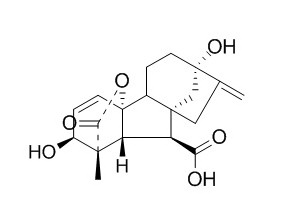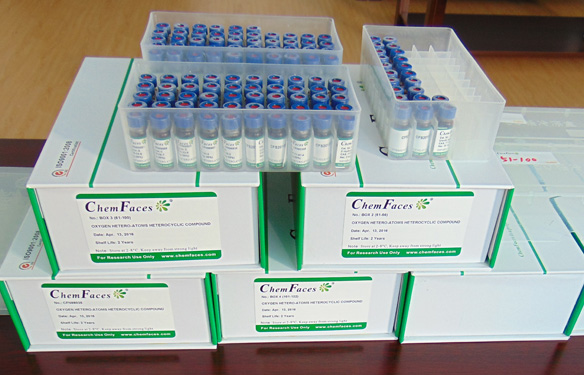Gibberellins
Gibberellins are growth-promoting phytohormones that were crucial in breeding improved semi-dwarf varieties during the green revolution. Gibberellin shows inhibitory effect on treatment on adventitious rooting, which appears to act by perturbing polar auxin transport, in particular auxin efflux in hybrid aspen, and both efflux and influx in Arabidopsis.
Inquire / Order:
manager@chemfaces.com
Technical Inquiries:
service@chemfaces.com
Tel:
+86-27-84237783
Fax:
+86-27-84254680
Address:
1 Building, No. 83, CheCheng Rd., Wuhan Economic and Technological Development Zone, Wuhan, Hubei 430056, PRC
Providing storage is as stated on the product vial and the vial is kept tightly sealed, the product can be stored for up to
24 months(2-8C).
Wherever possible, you should prepare and use solutions on the same day. However, if you need to make up stock solutions in advance, we recommend that you store the solution as aliquots in tightly sealed vials at -20C. Generally, these will be useable for up to two weeks. Before use, and prior to opening the vial we recommend that you allow your product to equilibrate to room temperature for at least 1 hour.
Need more advice on solubility, usage and handling? Please email to: service@chemfaces.com
The packaging of the product may have turned upside down during transportation, resulting in the natural compounds adhering to the neck or cap of the vial. take the vial out of its packaging and gently shake to let the compounds fall to the bottom of the vial. for liquid products, centrifuge at 200-500 RPM to gather the liquid at the bottom of the vial. try to avoid loss or contamination during handling.
Plos One.2020, 10.1371
Srinakharinwirot University2023, 2669.
Biomolecules2021, 11(10),1513.
Molecules.2020, 25(9):2081.
bioRxiv - Biochemistry2023, 541790.
Chemistry of Natural Compounds2018, 204-206
Int J Mol Sci.2021, 22(8):4211.
Front Pharmacol.2021, 12:764297.
Fitoterapia.2024, 106006.
Journal of Functional Foods2022, 91:105019.
Related and Featured Products
Plant J. 2014 May;78(3):372-84.
Gibberellins inhibit adventitious rooting in hybrid aspen and Arabidopsis by affecting auxin transport.[Pubmed:
24547703]
Knowledge of processes involved in adventitious rooting is important to improve both fundamental understanding of plant physiology and the propagation of numerous plants. Hybrid aspen (Populus tremula × tremuloïdes) plants overexpressing a key gibberellin (GA) biosynthesis gene (AtGA20ox1) grow rapidly but have poor rooting efficiency, which restricts their clonal propagation. Therefore, we investigated the molecular basis of adventitious rooting in Populus and the model plant Arabidopsis.
METHODS AND RESULTS:
The production of adventitious roots (ARs) in tree cuttings is initiated from the basal stem region, and involves the interplay of several endogenous and exogenous factors. The roles of several hormones in this process have been characterized, but the effects of GAs have not been fully investigated. Here, we show that a GA treatment negatively affects the numbers of ARs produced by wild-type hybrid aspen cuttings. Furthermore, both hybrid aspen plants and intact Arabidopsis seedlings overexpressing AtGA20ox1, PttGID1.1 or PttGID1.3 genes (with a 35S promoter) produce few ARs, although ARs develop from the basal stem region of hybrid aspen and the hypocotyl of Arabidopsis. In Arabidopsis, auxin and strigolactones are known to affect AR formation.
CONCLUSIONS:
Our data show that the inhibitory effect of GA treatment on adventitious rooting is not mediated by perturbation of the auxin signalling pathway, or of the strigolactone biosynthetic and signalling pathways. Instead, GAs appear to act by perturbing polar auxin transport, in particular auxin efflux in hybrid aspen, and both efflux and influx in Arabidopsis.
Mol Plant. 2014 Jun;7(6):943-59.
Connecting growth and defense: the emerging roles of brassinosteroids and gibberellins in plant innate immunity.[Pubmed:
24777987]
METHODS AND RESULTS:
Brassinosteroids (BRs) and Gibberellins (GAs) are two groups of phytohormones that regulate many common developmental processes throughout the plant life cycle. Fueled by large-scale 'omics' technologies and the burgeoning field of plant computational biology, the past few years have witnessed paradigm-shifting advances in our understanding of how BRs and GA are perceived and their signals transduced. Accumulating evidence also implicates BR and GA in the coordination and integration of plant immune responses. Similarly to other growth regulators, BR and GA play ambiguous roles in molding pathological outcomes, the effects of which may depend not only on the pathogen's lifestyle and infection strategy, but also on specialized features of each interaction. Analysis of the underpinning molecular mechanisms points to a crucial role of GA-inhibiting DELLA proteins and the BR-regulated transcription factor BZR1. Acting at the interface of developmental and defense signaling, these proteins likely serve as central hubs for pathway crosstalk and signal integration, allowing appropriate modulation of plant growth and defense in response to various stimuli.
CONCLUSIONS:
In this review, we outline the latest discoveries dealing with BR and GA modulation of plant innate immunity and highlight interactions between BR and GA signaling, plant defense, and microbial virulence.
Trends Plant Sci. 2014 Apr;19(4):231-9.
Gibberellins and DELLAs: central nodes in growth regulatory networks.[Pubmed:
24182663]
Gibberellins (GAs) are growth-promoting phytohormones that were crucial in breeding improved semi-dwarf varieties during the green revolution. However, the molecular basis for GA-induced growth stimulation is poorly understood.
METHODS AND RESULTS:
In this review, we use light-regulated hypocotyl elongation as a case study, combined with a meta-analysis of available transcriptome data, to discuss the role of GAs as central nodes in networks connecting environmental inputs to growth. These networks are highly tissue-specific, with dynamic and rapid regulation that mostly occurs at the protein level, directly affecting the activity and transcription of effectors.
CONCLUSIONS:
New systems biology approaches addressing the role of GAs in growth should take these properties into account, combining tissue-specific interactomics, transcriptomics and modeling, to provide essential knowledge to fuel a second green revolution.



